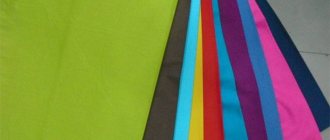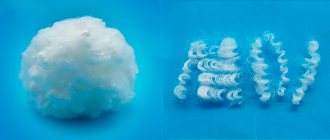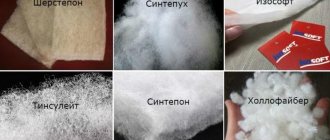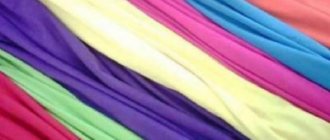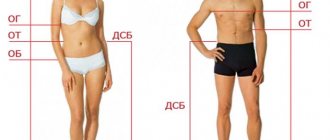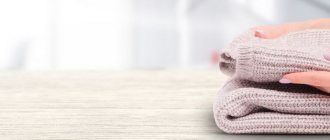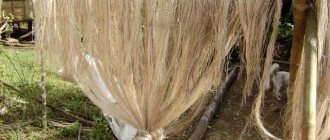Caring for knitwear
As you know, knitwear requires special care. Therefore, in order for knitted home clothes to serve you longer, you should adhere to some rules and recommendations for caring for knitted products, namely:
- First of all, you need to read the label on the product to find out the appropriate washing, spinning, and drying modes.
- Knitwear made from cotton, wool, chemical fibers and their mixtures should be washed in warm water up to 40°C in a soap solution, using mild detergents specifically designed for washing knitwear, otherwise deformation and shrinkage of the items may occur. When washing in the washing machine, use a gentle, delicate wash cycle.
- It is advisable to wash any knitwear by hand and squeeze it rather than rub it, otherwise pilling may appear on it.
- When washing knitwear, you should not use detergents containing all types of bleaches, bioadditives (enzymes), alkalis and their compounds, or colored granules.
- Products of different colors must be washed separately from each other, since lint from one product may stick to another product, and subsequent cleaning will be labor-intensive.
- It is not recommended to soak the product for a long time, no more than 20 minutes. The water should be cool, because in hot water the knitwear shrinks and falls off.
- Products made from artificial and synthetic threads, light-colored products with colored patterns or finishing materials, products with hot-melt patterns, three-dimensional printing or embroidery cannot be soaked or boiled.
- Rinse knitwear first in warm and then in cold water.
- To keep knitted items soft and fluffy, add glycerin to the water when rinsing in a ratio of 1 teaspoon per 1 liter of water. And then rinse again in cold water with the addition of ammonia in the same proportion.
- Knitted items should be wrung out gently, without twisting. It is recommended to briefly wrap the product in a dry towel or sheet.
- Knitwear should be dried flat on a horizontal surface at room temperature. Hanging knitted items is not recommended, as they can stretch and lose their shape.
- It is necessary to iron knitted items from the wrong side and in the direction of the loops with a moderately heated iron, no more than 110°C.
- Remember, if a knitted product has finishing inserts made of suede, leather or fur, it is better not to experiment and take it to the dry cleaner.
- Knitwear has a loop structure, so when wet, you can slightly change the linear dimensions: lengthen or shorten the sleeves, change the length of the product.
- Due to improper care of knitted products, lumps of matted fibers - pellets - often form on them. It is best to remove pellets with a special brush or a special peeling machine.
- Also, if you do not wear the item for a long time, you should store it folded, since hangers can distort the shape of the knitwear. When storing knitted clothes, it is recommended to use plastic boxes to protect them from bugs and moths.
Caring for cotton products
Cotton fabrics are durable and resistant to high temperatures, and also absorb moisture well. May shrink when washed.
- For cotton items, it is recommended to hand wash in warm water at 30 - 40°C, or machine wash on a delicate cycle. For colored products, a powder labeled “Color” is recommended. It is not recommended to use powder with bleaching additives, and such products cannot be bleached.
- If the product sheds a lot, it should be washed in cold water and dried flat immediately after rinsing. For rinsing, it is recommended to add salt to the water (1 tablespoon per 10 liters of water).
- If the product is slightly colored, just fill it with hot water with the addition of soda and leave for 10 - 12 hours, then wash and rinse several times.
- Use the dryer only if recommended by the manufacturer. If you dry a product outdoors, you must take into account that fabrics can fade in the bright sun, and negative temperatures can promote bleaching, which is undesirable for colored and black products.
- Ironing is an equally important process, in which you also need to know some subtleties. Cotton is ironed wet from the front side, and if the fabric has embroidery or a print, it is ironed from the back.
- You can iron cotton with a high temperature iron.
Fabric care
Acrylic. Hand wash in water at room temperature or on a delicate cycle in a machine. After the water has drained from the washed item, wrap it in a terry towel or sheet and gently wring it out. Then the product is laid out to dry. It is allowed to iron with a minimally heated iron through a double layer of moistened gauze.
Acetate. The material is soft and light, but is highly electrified and not wear-resistant. Recommended hand wash or delicate cycle in a machine. When rinsing, it is advisable to add an antistatic agent. Clothes should only be ironed from the inside out through a damp cloth.
Polyester. Washing temperature – no more than 40 degrees, rinse with the addition of an antistatic agent. When drying and storing flat, items do not require ironing. If clothes need to be ironed, use the iron in silk mode (up to 150 degrees) with moisture. Heavily wrinkled items are ironed at temperatures above 150 degrees, but through a damp cotton cloth.
Elastane, polyurethane, polyamide. Synthetic fibers of these varieties are added to various fabrics. They increase strength and provide elasticity of the material, but worsen its “breathing” properties.
Recommended washing at 30 degrees with special detergents for wool and silk. Things should not be dried in the sun. To iron the product, set the iron regulator to the “synthetic” or “nylon” position.
Following the rules for caring for clothes made from fabrics with artificial fibers will help maintain a fresh and attractive appearance for a long time, despite the need for frequent washing.
Caring for viscose products
Viscose fiber, when processed differently, can resemble silk, cotton or even wool in its luster and density. Products made from viscose absorb moisture well, but when wet they lose strength, so they require especially careful washing.
- Viscose can be washed in a washing machine on a gentle cycle at a temperature of 30 – 40°C or by hand with washing powder for delicate fabrics or using mild detergents.
- Viscose cannot be rubbed, twisted, much less squeezed in a centrifuge.
- Viscose items can be hung to dry without wrung out, or they can be rolled into a sheet and gently wrung out.
- Iron viscose products damp or through a damp cloth at a temperature of 150°C, with the iron thermostat set to “silk”.
- Products made from viscose fabric can be dry cleaned.
Compatibility with other materials
Polyester fibers are used both independently and in combination with other materials. Such combinations give the material special properties.
Thanks to mixture combinations:
- performance improves, which directly affects the wear time of products;
- It will be easier to take care of things, they will not “shrink”, and will become more elastic.
Synthetic threads can be combined with natural or artificial fibers. It can be viscose, cotton, linen, polyamide.
In its pure form, 100% polyester is a rigid fabric that, when compressed, still returns to its original shape. Combination with other materials allows you to obtain a canvas with improved characteristics.
- Cotton. When adding synthetics to cotton, although some of the hygienic qualities of natural fabric decrease, this will be compensated by other advantages. Thanks to mixing, the fabric becomes stronger and more durable. Such products do not require special care; they do not need to be ironed. The price of the finished item is reduced. Polyester-cotton fabric is suitable for sewing home clothing and textiles.
- Wool. The combination with wool fibers leads to a significant increase in the service life of the material. Such products begin to wrinkle less, they can be washed in a washing machine, wrung out, they become resistant to wear and abrasion. Externally, such material cannot be distinguished from wool, especially if the proportion of synthetic fibers in it does not exceed 30%.
- Linen. Finished items made from polyester fibers and linen will be much more practical than those without synthetic additives.
As a result of such combinations, materials are obtained that are distinguished by improved characteristics, which in appearance will practically not differ from natural fabrics.
Caring for modal products
Modal is a modernized viscose fiber, so it needs to be cared for in the same way as viscose products.
- When washing modal items, it is advisable to turn them inside out and avoid using bleaches, as they can cause pilling.
- Due to the fact that the smooth surface of this fiber does not allow detergents to remain on the fabric, making it hard to the touch, modal products remain soft and elastic even after repeated washing, and almost do not shrink, so they are easy to care for.
Caring for polyester products
Products made from polyester are easy to wash and dry in a machine and can withstand dry cleaning well. Polyester should be removed from the machine immediately after the drying cycle is complete. When ironing, the iron should be warm, but not hot.
- Polyester can be washed in a washing machine at 40°C. At higher temperatures, wrinkles form on the fabric, which are then almost impossible to remove. True, some polyester fibers tolerate temperatures of 60°C.
- White fabrics should be washed with universal powder, colored fabrics with powder for delicate fabrics.
- Polyester can only be slightly dried in a machine at a low temperature, but in no case to dryness. In this case, it is necessary to follow the care instructions indicated on the label so that difficult-to-remove wrinkles do not appear.
- Polyester does not require ironing, but if it is still needed, it must be ironed with a moderately heated iron through a damp cloth, the iron thermostat should be in the “silk” position.
- Polyester items can be dry cleaned.
How to care for synthetic fabrics
If the product does not have a label with care instructions, but the composition of the fabric is known, then you should use the following rules.
Acrylic
Soft and warm fabric that retains its shape well and does not fade or shrink.
Washable by hand or in a machine at a temperature of no more than 30 degrees without twisting and automatic drying. An antistatic agent is added to the rinse water. Ironing items is not recommended.
Acetate
Fabric reminiscent of natural silk, elastic, holds its shape well.
Products should be washed manually or using a gentle cycle in an automatic machine at a temperature of no more than 40 degrees. Automatic drying and ironing of items is not recommended.
Viscose
High-quality fabric with a matte or shiny surface, with a texture imitating linen, silk, wool, cotton. Things perfectly absorb moisture and remove it quickly, allow air to pass through well, and are wear-resistant.
Washable at 30 degrees on delicate or gentle cycles, cannot be spun or machine dried. Products can be ironed using a damp cloth.
Polyamide
Innovative material of high strength, resistant to deformation, wear, and breathable.
You can wash things at a temperature of no more than 40 degrees, hang them damp, iron them with a warm iron without using steam.
Polyacrylic
Lightweight, soft and durable fabric that repels water well and has high heat-saving properties.
Usually, clothes are made from polyacrylic for the cold season, which can be washed in cool water (not higher than +30 degrees) and ironed at low or medium temperature.
Polyester
The fabric is durable and wear-resistant; items made from polyester hold their shape well and do not fade.
Washing is carried out in water no more than +40 degrees using detergents for delicate fabrics. Push-ups in a centrifuge or manual twisting are not allowed. Ironing is carried out on the “silk” mode.
Elastane
Highly elastic fabric made of polyurethane threads, thin, durable, resistant to dirt, chemical bleaches and ultraviolet radiation.
Products should be washed with detergents intended for delicate fabrics; automatic drying should not be used. There is no need to iron things, as they do not wrinkle.
Basic symbols
| Washing including soaking, pre-washing, rinsing, heating and mechanical action |
| Whitening |
| Ironing and pressing under the influence of heat, a method of restoring shape and appearance under the influence of an appropriate device |
| Dry cleaning using organic solvents |
| Drying after washing in a machine or other suitable method |
Symbols indicating washing conditions
| The product may be subject to boiling. No special care required when machine washing. Mechanical action, rinsing without temperature check and centrifugation correspond to the normal machine program |
| The product can be machine washed at a temperature not exceeding 95°C. Mechanical action, rinsing at a constantly decreasing temperature and centrifugation correspond to a moderate machine program |
| The product can be machine washed at a temperature not exceeding 60°C. Mechanical action, rinsing at a constantly decreasing temperature and centrifugation correspond to the normal machine program |
| The product can be machine washed at a temperature not exceeding 60°C. Mechanical action, rinsing at a constantly decreasing temperature and centrifugation correspond to a moderate machine program |
| The product can be machine washed at a temperature not exceeding 40°C. Mechanical action, rinsing at a temperature not exceeding 40°C and centrifugation correspond to the normal machine program |
| The product can be machine washed at a temperature not exceeding 40°C. Mechanical action, rinsing and centrifugation correspond to a moderate machine program |
| The product can be machine washed at a temperature not exceeding 30°C. Mechanical action, rinsing at a temperature not exceeding 30°C and centrifugation correspond to the normal machine program. |
| The product can be machine washed at a temperature not exceeding 30°C. Mechanical action, rinsing and centrifugation correspond to a moderate machine program |
| Washing should only be done by hand at a temperature of no more than 40°C for a short period of time. When washing, the product should only be washed or wrung lightly by hand without twisting. |
| The product should not be washed |
Pique
Loved by athletes, entrepreneurs and fashionistas, pique knit fabric, known as lacoste, is easy to care for. It does not wrinkle or stretch. To ensure that pique clothing retains its shape and color for a long time, it is recommended:
- Machine washable at temperatures up to 40˚C
- iron according to label instructions
- It is permissible to use gentle stain removers
- dense pique is recommended to be starched
- machine drying is acceptable
Symbols indicating dry cleaning conditions
| Dry cleaning of the product can be carried out using all generally accepted organic solvents |
| Dry cleaning of the product can be done using tetrachlorethylene (perchlorethylene), gasoline, trifluorotrichloroethylene, or mono-fluorotrichloromethane using conventional cleaning processes |
| When dry cleaning, some care is required depending on the solvent used, mechanical stress and drying temperature. The product can be cleaned using tetrachlorethylene (perchlorethylene), gasoline, trifluorotrichlorethylene, or monofluorotrichloromethane with limited addition of water |
| Dry cleaning of the product can only be carried out with gasoline or trifluorotrichloroethane using conventional cleaning processes |
| When dry cleaning, special care is required depending on the mechanical stress and temperature during drying. The product can only be cleaned using gasoline or trifluorotrichloroethane with limited addition of water. |
| The product must not be dry cleaned |
Symbols indicating drying conditions after washing
| The product can be dried in a drum dryer (tumbler). No special care required |
| Tumble drying is prohibited |
| Items saturated with moisture should only be hung to dry |
| Products saturated with moisture should only be laid out on a flat surface to dry. |
The symbols on the labels attached to the clothing are instructions for the care of the products, which must be followed. By following these instructions, indicated by manufacturers on clothing labels, you can significantly extend the service life of your favorite knitwear products!
Oxford
Oxford fabric is distinguished by a special “basket” weaving of fibers; its composition can be natural or synthetic. Recommendations for fabric care vary depending on the composition.
Cotton Oxford
Clothes are washed by hand or machine at 40°C. Both powder and gel are suitable. The fabric can be ironed, but should not be dried in the sun: it will fade. The best way is to dry in a well-ventilated area, after wrung out and straightening the product.
Polyester and Nylon Oxford
Oxford made of synthetic materials can be hand and machine washed at a temperature not exceeding 40°C. The fabric does not wrinkle, but if necessary, polyester oxford can be ironed at temperatures up to 110°C.
Nylon oxford cannot be ironed, and it is better to use a special gel for washing.
